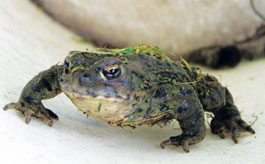home | north bay bohemian index | columns | wine tasting room of the week

Eye of the Toad
By James Knight
On account of the rainy weather, inattention, sheer laziness, whatever—I'd failed to spray herbicide this winter, so a-weed-whacking I went. As green stalks of grass and weeds shredded into a fine spray of cellulose, I spied a wriggling, glistening spot on the ground. A large toad, crouched in a shallow depression, had escaped a most unpleasant end by merely half an inch. So sorry, Mr. Toad, I said as I scooped him up and, after a brief photo shoot, brought him to an undisturbed marshy area. I promise that I'll "Roundup" on schedule next time. Ah, but there's the rub. Glyphosate, the main ingredient in Monsanto's popular herbicide, is toxic to aquatic organisms. While it works by interrupting a biosynthetic pathway that plants have and animals don't, glyphosate is more than controversial. When I call the office of the Sonoma County Agricultural Commissioner to ask advice on its use, I'm simply told, "We go by the label." Which label (roughly) says: Don't spray it on water, and you're cool. As a venerable viticultural instructor once crowed reassuringly—and inaccurately—to our class, "Hell, you can practically drink the stuff!"
Virginia Lambrix, biodynamic consultant at Truett-Hurst Winery, is not so sanguine about Roundup's unknown-unknowns. "Does mechanical weed-whacking and cultivation, mowing, cost more with respect to both time and fossil fuels?" she asks. "Yes. But at least I have a better idea as to the consequences—a decapitated toad or sliced earthworm—than with the chemical approach."
If I could ask an anthropomorphized Mr. Toad, I'm sure my soft-hearted self-interest and his would harmonize. "Put down that noisy thing, my good fellow. I'd much rather, er, take my chances with that weed-be-gone spritzer of yours than face the string. Besides, I wouldn't bother with an old, bare patch of ground, anyway." But for Lambrix, that lifeless dirt is the problem, starting a cycle of dependence on chemical fertilizers and fungicides that replace the effects of beneficial microorganisms. We just don't have to look at their eyes. One way or the other, I guess that for all the boasting on slick brochures about how lightly a winery treads on the earth, the making of good red wine is not a bloodless business. Apropos of nothing but the name, let's taste Toad Hollow Vineyard's 2008 "Eye of the Toad" Dry Pinot Noir Rosť (for which I'm told "no toads were harmed"). Sourced from a sustainably farmed Carneros vineyard, this rosť has aromas of rose blossom and guava, and while bone-dry, has a satisfying weight on the palate. At only 11 percent alcohol, it won't hurt too much; but a few glasses put me in pleasant repose, at a comfortable distance from unhappy memories of Mr. Vole. Oh, let us not even speak of Mr. Vole.
Toad Hollow's current release is the 2009 Dry Pinot Noir Rosť ($8.99). Toad Hollow, 409-A Healdsburg Ave., Healdsburg. 707.431.8667. Truett-Hurst Winery, 5610 Dry Creek Road, Healdsburg. 707.433.9545.
Send a letter to the editor about this story.
|
|
|
|
|
|